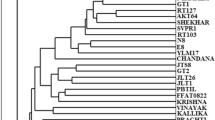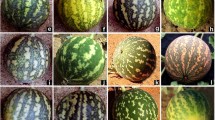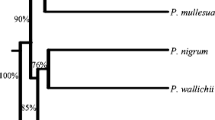Abstract
Random amplified polymorphic DNA (RAPD) markers were utilized for the identification of Lilium species and inter-specific hybrids. The optimum annealing temperature of the polymerase chain reaction (PCR) for the RAPD assay in Lilium was 54 °C, which is relatively higher than the temperature used for other genera reported by previous researchers. Among 76 primers used to amplify genomic DNA by PCR, 18 primers (24%) generated polymorphic DNA fragments in Lilium species and hybrids. Cultivars were also identified by RAPD markers. Some amplified fragments were unique to species of each section and to hybrids derived from these species; that is, they were the section-specific DNA markers. Sections, Sinomartagon, Leucolirion b, Leucolirion a and Archelirion could be identified by 6 section-specific markers amplified with five primers. Seven inter-section hybrids showed the section-specific bands of both parental sections, indicating that these markers would be useful for identifying the parental sections of inter-section hybrids.
Similar content being viewed by others
References
Asano Y (1978) Studies on crosses between distantly related species of lilies. III. New hybrids obtained through embryo culture. J Jpn Soc Hortic Sci 47:401–414
Asano Y (1989) Lilium L. In: Tsukamoto Y (ed) The grand dictionary of horticulture, vol 5. Syogakukan, Tokyo, pp 198–209
Baird E, Cooper-Bland S, Waugh R, De Maine M, Powell W (1992) Molecular characterization of inter-and intra-specific somatic hybrids of potato using randomly amplified polymorphic DNA (RAPD) markers. Mol Gen Genet 233:469–475
Caetano-Anollés G, Bassam BJ, Gresshoff PM (1992) Primer-template interactions during DNA amplification fingerprinting with single arbitrary oligonucleotides. Mol Gen Genet 235:157–165
Cox AV, Bennett MD, Dyer TA(1992) Use of the polymerase chain reaction to detect spacer size heterogeneity in plant 5S-rRNA gene clusters and to locate such clusters in wheat (Triticum aestivum L.). Theor Appl Genet 83:684–690
Hirochika H, Fukuchi A, Kikuchi F (1992) Retrotransposon families in rice. Mol Gen Genet 233:209–216
Kochko AD, Kiefer MC, Cordesse F, Reddy AS, Delseny M (1991) Distribution and organization of tandemly repeated 352-bp sequence in the Oryzae family. Theor Appl Genet 82:57–64
Leeton PRJ, Smyth DR (1993) An abundant LINE-like element amplified in the genome of Lilium speciosum. Mol Gen Genet 237:97–104
Leslie AC (1982) The international lily register, 3rd edn. The Royal Horticultural Society, London
Matsuyama T, Motohashi R, Omura M, Akihama T (1992) DNA fingerprinting using PCR in Citrus cultivars. Jpn J Breed 42 [Supp11]: 306–307
Okazaki K, Asano Y, Oosawa K (1994) Interspecific hybrids between Lilium ‘Oriental’ hybrid and L. ‘Asiatic’ hybrid produced by embryo culture with revised media. Breed Sci 44:59–64
Reed KC, Mann DA (1985) Rapid transfer of DNA from agarose gels to nylon membranes. Nucleic Acids Res 13:7207–7221
Rogers SO, Bendich AJ (1988) Extraction of DNA from plant tissues. In:Gelvin SB, Schilperoort RA, Verma DS (eds) Plant molecular biology manual, sect A/6. Kluwer Academic Publ, Dordrecht, pp 1–10
Smyth DR, Kongsuwan K, Wisudharomn S (1989) A survey of C-band patterns in chromosomes of Lilium (Liliaceae). Plant System Evol 163:53–69
Vassart G, Georges M, Monsieur R, Brocas H, Lequarre AS, Christophe D (1987) A seaquence in M13 phage detects hypervariable minisatellites in human and animal DNA. Science 235:683–684
Weining S, Langridge P (1991) Identification and mapping of polymorphisms in cereals based on the polymerase chain reaction. Theor Appl Genet 82:209–216
Welsh J, Honeycutt RJ, McClelland M, Sobral BWS (1991) Parentage determination in maize hybrids using the arbitrarily primed polymerase chain reaction (AP-PCR). Theor Appl Genet 82:473–476
Williams JGK, Kubelik AR, Livak KJ, Rafalski JA, Tingey SV (1990) DNA polymorphisms amplified by arbitrary primers are useful as genetic markers. Nucleic Acids Res 18:6531–6535
Xu Y, Clark MS, Pehu E (1993) Use of RAPD markers to screen somatic hybrids between Solarium tuberosum and S. brevidens. Plant Cell Rep 12:107–109
Zhao X, Kochert G (1992) Characterization and genetic mapping of a short, highly repeated, interspersed DNA sequence from rice (Oryza sativa L.). Mol Gen Genet 231:353–359
Author information
Authors and Affiliations
Additional information
Communicated by K. Tsunewaki
Rights and permissions
About this article
Cite this article
Yamagishi, M. Detection of section-specific random amplified polymorphic DNA (RAPD) markers in Lilium . Theoret. Appl. Genetics 91, 830–835 (1995). https://doi.org/10.1007/BF00223888
Received:
Accepted:
Issue Date:
DOI: https://doi.org/10.1007/BF00223888




